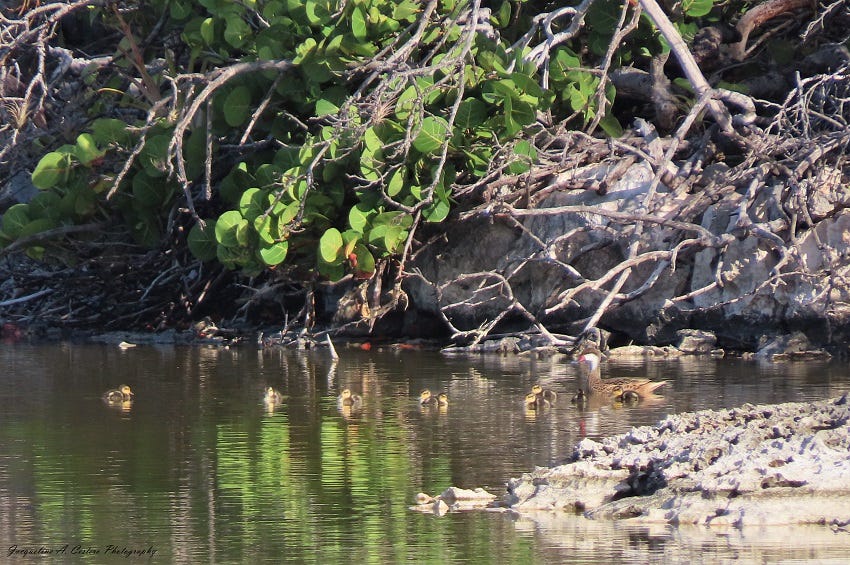Directly on the heels of the Caribbean Waterbird Census, I participated in the Cornell Lab-sponsored Great Backyard Bird Count. Over four days, “the world comes together for the love of birds.”
A bit of history from their website:
“Launched in 1998 by the Cornell Lab of Ornithology and National Audubon Society, the Great Backyard Bird Count (GBBC) was the first online citizen-science project (also referred to as community science) to collect data on wild birds and to display results in near real time. Birds Canada joined the project in 2009 to provide an expanded capacity to support participation in Canada. In 2013, we became a global project when we began entering data into eBird, the world’s largest biodiversity-related citizen science (community science) project.”
When I first participated in this count over 12 years ago, I confined my counts to the area around my house (the “backyard”). For the last ten years, I have also surveyed wetlands and beaches.
Over the four days (February 17-20), I identified 56 species with notable differences from the Caribbean Waterbird Census. On the first morning, I was treated to the beautiful Merlin above. This bird has established new territory at Bad Cox Pond after a bulldozer destroyed its long-standing habitat in Island Harbour.
Bad Cox Pond provided lovely views of a happy family of White-cheeked Pintails. A true cuteness overload!
The American Coot pair on Forest Bay completed their nest and are taking turns incubating eggs. I anxiously await the arrival of their chicks.
The male Lesser Scaup is still present at this site. Two male American Wigeons have joined the waterfowl species found here. I last saw this species in Anguilla in 2019.
A juvenile Little Blue Heron was observed briefly before it flew off. This is my second record of a juvenile bird since the Fall.
I captured a clear view of the White-tailed Tropicbird in Little Bay. Nesting activity at that location has ramped up, with Red-billed and White-tailed tropicbirds nesting in the cliffs.
In one of those “only in Anguilla” moments, I was advised by Mr. Connor at Bad Cox Pond of a Tamarind Tree in Blowing Point, where I would find a large number of Cattle Egrets roosting. After a few twists and turns, I found the location only to realize it was a colony of nesting birds. It is located within a fenced area consisting of a stand of Wild Moses Trees. Although the view was obstructed, at least five nests were visible. Thank goodness for a camera that can peek through trees and zoom in close.


Did you know that Cattle Egrets only vocalize inside a breeding colony? This location was no exception, and the chatter was quite loud. You can bet I will return to further study this exciting new find!
While I was finally able to capture an Osprey during this count, the Peregrine Falcon remains elusive. My apologies for the poor shot of this bird, but it popped in unexpectedly. It circled the pond once and was gone again.
My last stop on the count was at Meads Bay Pond. The usual cast of characters was present, including a group of Black-necked Stilts and Snowy and Great Egrets. I was about to call it a day when a Great Blue Heron emerged from the undergrowth. It made its way along the edge hunting. I spent the next hour approximately 6 feet from this bird as it searched for prey in the grasses.
Upon further study, I found the color of the bird quite striking. There was a significant amount of brown coloration to the head and body. At first, I considered a plumage molt. But it seemed too much for this species.
I forwarded the photos to my eBird reviewer for his opinion. He initially considered the possibility of a hybrid species. Upon further study, this is what he had to say:
“I think that this is a weird GB Heron. Some of the features that I thought were atypical of GB Heron may not be. See https://macaulaylibrary.org/asset/314104171
The brown cap is odd, but might be due to staining, wear, etc.”
I have uploaded the photograph for the eBird record. I find it comforting to know that someone else found this individual challenging.
Despite the uncooperative weather, it was a great four days of immersing myself in nature!













Beautiful photos... my favourite this time is the Merlin. Thank you for sharing!
We arrive in two weeks. We arrive in 2 weeks and will look for these beauties! 😎🌈